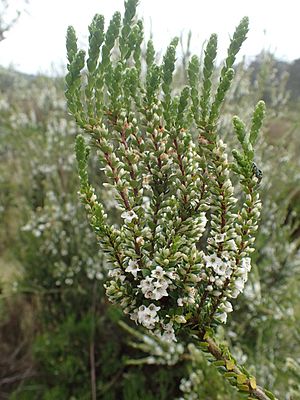Mountain coral heath facts for kids
Quick facts for kids Mountain coral heath |
|
|---|---|
 |
|
| Epacris rhombifolia in Barrington Tops National Park | |
| Scientific classification | |
| Genus: |
Epacris
|
| Species: |
rhombifolia
|
| Synonyms | |
|
|
The Mountain coral heath (scientific name: Epacris rhombifolia) is a special plant. It belongs to the heath family called Ericaceae. This plant is only found in eastern Australia, which means it is endemic there.
It is a shrub that stands tall and has many stems. Its leaves are broad and shaped like a diamond. The plant produces pretty white flowers with four petals. These flowers grow all along its branches. You can find Mountain coral heath only in wet, subalpine heath areas. Some people used to think it was just a type of Epacris microphylla.
Contents
What Mountain Coral Heath Looks Like
The Mountain coral heath is an upright shrub with several main stems. It can grow up to 2 metres (7 ft) (about 6.5 feet) tall. When the stems are young, they are reddish-brown and covered with soft, short hairs.
The leaves are shaped like a diamond, which is where the "rhombifolia" part of its name comes from. They are about 2.0–4.5 mm (0.08–0.2 in) long and 1.5–3.5 mm (0.06–0.1 in) wide. The leaves are mostly flat and overlap each other when they are new. They are smooth (meaning they have no hairs) and their veins are hard to see. Each leaf has a tiny stalk (called a petiole) about 0.3–0.8 mm (0.01–0.03 in) long.
The flowers are white and about 3.8–5 mm (0.1–0.2 in) wide. They grow where the leaves meet the stem (called leaf axils) and spread down the branches. The white petals form a bell-shaped tube. Before the flowers open, the buds are surrounded by 16 to 20 white, egg-shaped bracts. There are also white, egg-shaped sepals, which are about 1.5–2.5 mm (0.06–0.1 in) long. These sepals are longer than the petal tube.
The petal tube itself is about 1 mm (0.04 in) long and 1.5–2 mm (0.06–0.08 in) wide. The petal parts (called lobes) are about 1.7 mm (0.07 in) long and do not overlap. This plant flowers from December to March. After flowering, it produces small capsules (fruits) that are about 2 mm (0.08 in) long and wide.
How it Got its Name
The Mountain coral heath was first officially described in 1810. Two scientists, Lilian Fraser and Joyce Vickery, gave it the name Epacris microphylla var. rhombifolia. They published their description in a science journal called Journal and Proceedings of the Linnean Society of New South Wales.
Later, in 2015, Yvonne Menadue and Ron Crowden decided that this plant was different enough to be its own species. So, they changed its botanical name to Epacris rhombifolia.
The second part of its scientific name, rhombifolia, tells us something about the plant. It comes from two Latin words:
- rhombus: This means "a diamond shape" or "an equilateral parallelogram with unequal pairs of angles."
- folium: This means "leaf."
So, rhombifolia simply means "diamond-shaped leaf."
Where Mountain Coral Heath Grows
You can find Epacris rhombifolia growing in wet heathlands. These are special areas in the subalpine regions of Australia.
In Victoria, it grows in places like Lake Mountain, Mount Baw Baw, and the mountain ranges north of Licola. In New South Wales, you can find it in the Barrington Tops, Wingello, and Oberon areas.
Growing Mountain Coral Heath in Gardens
The Mountain coral heath is a beautiful plant that people like to grow in their gardens. Its delicate flowers make it very attractive.
It is a good choice for a small garden that stays wet and is protected from harsh weather. You can also grow it in pots or containers.
-
Epacris rhombifolia at Polblue Swamp, Barrington Tops National Park
-
Epacris rhombifolia habit at Polblue Swamp, Barrington Tops National Park





